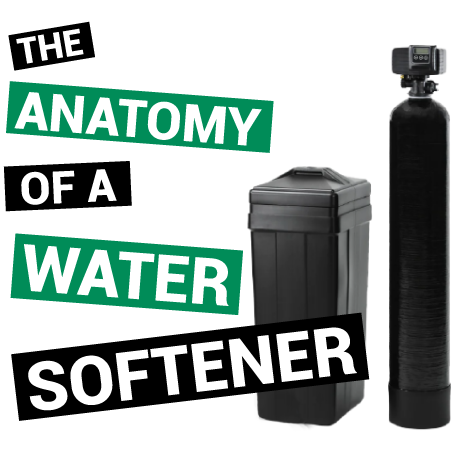
April 2024
By: Josh Walejewski
Read Time: 3 Minutes
In most Wisconsin homes, the water softener is a familiar fixture. You know, that big clunky thing-a-ma-jig in our basement that eats bags of salt in order to aid in our battle against hard water. Yet, despite routinely lugging heavy 40 lb. bags of salt into our basement every few months, how often do we pause to ponder the purpose behind this ritual? What role does salt play in softening our water? How does this contraption actually remove the hardness from our water?
For many homeowners, the need to understand the inner workings of our appliances remains optional or unnecessary. Often viewed through the lens of functionality rather than intrigue. However, if you’re like me, it can be fascinating to understand how our home’s appliances work. Taking a deeper dive can unveil unexpected insights as well as a newfound appreciation for the mechanisms that shape our home comfort.
Join us on a journey of discovery as we unravel the anatomy of the water softener. Together, we’ll explore not just how it softens water, but also shed light on the crucial role it plays in our homes.
The Role and Benefits of Soft Water
- Increases the life span of plumbing systems by preventing scale buildup and maintaining healthy flow rates
- Cleaner plumbing fixtures and reduced stains or hard water deposits on tubs, showers, shower heads, faucets
- Increases life span and efficiency of appliances such as water heaters, washing machines, dishwashers, and coffee machines
- Less spotting on dishes and glassware
- Water and soap lather better while also using up to 50% less soap. Leading to quicker and easier household cleaning
- Whiter, brighter, and softer clothes
- Smoother, softer, and healthier skin
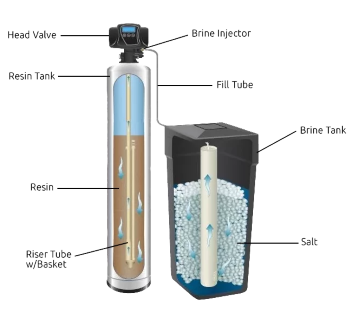
Hard vs Soft Water
Before we dive into how a water softener works, let’s look at the difference between hard and soft water. The hardness of water is determined by the amount of calcium and magnesium it contains.
When water contains high enough levels of dissolved calcium, magnesium, iron, and other minerals, it is classified as hard. Hardness is measured in milligrams per liter (mg/L), with soft water falling below 17 mg/L. Meanwhile hard water ranges from 121 mg/L to over 180 mg/L.
How a Water Softener Works
At the heart of every water softener lies a scientific process that transforms hard water into the silky-smooth liquid that flows effortlessly through our home’s plumbing system. The secret? A dance of ion exchange between resin beads, salt, and water—a choreography of chemistry that’s as intriguing as it is essential.
The Resin Beads:
Inside the water softener’s resin tank, millions of tiny beads await their moment to shine. These beads, coated with a negatively charged resin, act like a magnet for positively charged minerals like calcium, magnesium, and iron that plague our water. As hard water flows through the resin tank, the unwanted minerals cling to the resin beads, leaving the water flowing throughout your home soft and clean.
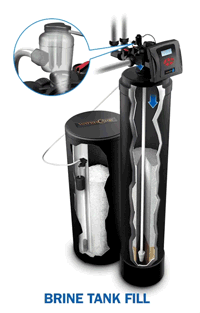
The Regen Cycle:
After so much hard water has passed over the resin beads, the regeneration cycle must begin. When the resin beads become saturated with minerals, it’s time for a thorough rinse and recharge. During regeneration, a carefully orchestrated sequence of backwashing, brine rinsing, and rinsing ensues, flushing out accumulated minerals and recharging the resin beads to their pristine state. This process ensures that your water softener remains at peak performance, ready to tackle the next wave of hard water. The entire regeneration process typically involves 5 stages: filling the brine tank, brining, brine rinse, backwash, and rapid rinse.
Filling the Brine Tank
Salt dissolved into water is known as brine. The saltwater solution or brine is essential in the regeneration process. During this stage, your water softener will fill the container where salt is stored with water to create brine.
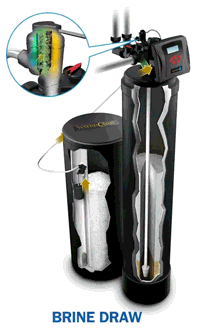
Brining
After the brine tank has been filled with water, the brine takes about 20 – 40 minutes to set up. Shortly after, brine is drawn into the resin tank to percolate through the beads in the resin tank. This is where the magic happens.
As we touched on earlier, the resin beads are negatively charged and the minerals the softener captures are positively charged. The brine solution serves as the catalyst for ion exchange, swapping sodium ions (from the brine) for the calcium and magnesium ions that cling stubbornly to the resin beads. In essence, the salt releases all the captured minerals and recharges the resin beads, priming them for another round of mineral removal.
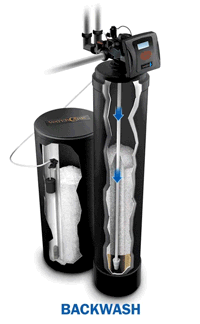
Brine Rinse
During the brine rinse cycle, water flows through the same path as during the brining stage, without the salty solution. During this stage, the minerals that were captured are flushed from the system entirely along with most of the brine.
Backwash
During the backwash stage, water is flushed in reverse from the bottom upwards and through the large resin tank at a higher velocity. This helps to flush the leftover sediments, iron, and dirt from the system that may have not been removed during the brine rinse.
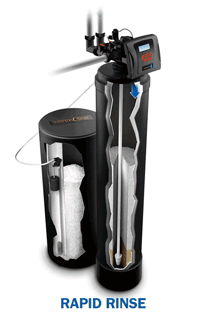
Rapid Rinse
After the backwash process concludes, a rapid rinse begins, with water swiftly flowing from the top downwards through the resin tank. During this phase, any residual brine lingering at the tank’s base is swept up by the flowing water, ensuring thorough contact with the resin beads. Once this final stage is complete, the water softener resumes its standard softening operation until the next regeneration cycle.
Final Thoughts
After gaining a new understanding of the intricate workings of our water softeners, we gain not just a deeper understanding of its mechanics and chemistry, but also a newfound appreciation for the role it plays in enhancing our daily lives. So, the next time you lug a few heavy bags of salt into your basement, take a moment to marvel at the science and chemistry unfolding within your water softener.
Read more blog posts from Kettle Moraine Heating & AC.
About the Author
Josh Walejewski
Josh is a professional marketer who has worked in the HVAC industry since 2017. With a Bachelor of Applied Arts and Sciences Degree (B.A.A.S) in marketing and sustainable business management from the University of Wisconsin, he has a passion for all aspects of HVAC, business, marketing, and environmental stewardship.





